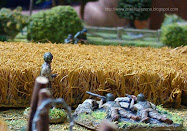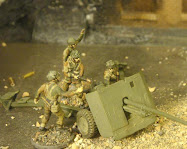ARMOURED CAVALRY UNITS.
ANTITANK UNITS.

Anti-tank refers to any method of combating military
armored fighting vehicles, notably
tanks. The most common anti-tank systems include
artillery with a high
muzzle velocity,
missiles (such as
wire-guided HEAT), various
autocannons firing penetrating ammunition, and
anti-tank mines.
In the area of anti-tank warfare, three terms are often used: "
mobility kill", "
firepower kill", and "
catastrophic kill". In a mobility kill (M-kill), the vehicle loses its ability to move, for example, by breaking a
tank track; the target is then immobile but may retain full use of its weapons and still be able to fight to some extent. A firepower kill (F-kill) is some loss of the vehicle's ability to fire its weapons. M-kills and F-kills may be complete or partial, the latter corresponding to reductions in a target's ability to move or fire. A catastrophic kill (K-kill) removes the tank's ability to fight completely; this may entail complete destruction of the tank or disabling the weapon system(s) or crew.
INFANTERY.


The Infantry is the oldest and most numerous of the
Combat Arms in the
armed forces, and consists of soldiers who predominantly fight on foot; an infantry soldier is an infantryman. Infantry units are the only types of land forces that can occupy and hold positions, and therefore have the most physically demanding training in the
army, emphasizing
physical fitness,
physical strength, and
aggressive character due to non-reliance on technology that augments
marching all of which are required due to the primary role of the infantry to
engage in ground
combat.
Infantry can be distinguished from other types of soldiers:
cavalry,
tanks, technicians such as
armourer and
signaller. Nonetheless basic infantry skills are fundamental to the training of any soldier, and soldiers of any branch of an army are expected to serve as auxiliary infantry (i.e.
patrol and fight on foot) when necessary.
MOUNTAIN ARTILLERY.

Mountain guns are
artillery pieces designed for use during
mountain combat. They are similar to
infantry support guns, and are generally capable of being broken down into smaller loads (for transport by
horse,
human,
mule,
tractor, and/or
truck). Due to their ability to be broken down into smaller "packages", they are sometimes referred to as pack guns or pack
howitzers.
ARMOURED ARTILLERY.


Self-propelled
artillery (also called mobile artillery or locomotive artillery) vehicles are a way of giving mobility to
artillery. Within the term are covered
Self-propelled guns (or
howitzers) and
rocket artillery. They are high mobility vehicles, usually based on
caterpillar track carrying either a large
howitzer or other field gun or alternatively a
mortar or some form of
rocket or missile launcher. They are usually used for long-range
indirect bombardment support on the battlefield.
In the past, self-propelled artillery has included direct fire vehicles such as
assault guns and
tank destroyers. These have been heavily armoured vehicles, the former providing close fire-support for infantry and the latter acting as specialized anti-tank vehicles.
ANTI-AIRCRAFT ARTILLERY.


A self-propelled anti-aircraft weapon (SPAA, also self-propelled air defense, SPAD, or self-propelled anti-aircraft gun, SPAAG) is an
anti-aircraft gun or
surface-to-air missile launcher mounted on a mobile vehicle
chassis. The
Russian equivalent of SPAAG is ZSU, for zenitnaya samokhodnaya ustanovka, ("anti-aircraft self-propelled mount").
Specific weapon systems include
machine guns,
autocannon, larger guns, or
missiles, and some mount both guns and longer-ranged missiles. Platforms used include both
trucks and heavier
armored fighting vehicles such as
APCs and
tanks, which add protection from aircraft, artillery, and small arms fire for front line deployment.
ARMOURED ENGINEERS.

Combat engineering is a
combat service support role of using the knowledge, tools and techniques of
engineering by troops in peace and war, but specifically in
combat. A combat engineer, in many armies also called pioneer or
sapper, is a military specialist in using the tools and techniques of engineering under combat conditions, who may perform any of a variety of tasks.
Such tasks typically include
fortification,
bridge and
road construction or destruction, laying or clearing
landmines, neutralization of
improvised explosive devices (IEDs) and general engineering tasks under fire. More generally speaking, the combat engineer's tasks involve facilitating movement and support of friendly forces while impeding that of the enemy.
RECONNAISSANCE WHEELED ARMOURED UNITS.

Militarily, reconnaissance is the active seeking to determine a foe's intentions by collecting and gathering information about an enemy's composition and capabilities along with pertinent environmental conditions, via direct observation, usually by scouts or military intelligence soldiers especially trained in critical surveillance
TANK (ARMOURED VEHICLE).

A self-propelled anti-tank gun, or tank destroyer, is a type of
armoured fighting vehicle designed specifically to engage enemy armor forces, and not produced for an infantry support role. Most have been traditionally defined and produced as a tank like vehicle with only light armor and capable of a higher transit speed, usually possessing high maneuverability whose main gun is not turret mounted and so cannot rotate horizontally.
AMPHIBIOUS MECHANIZED INFANTRY.

Amphibious warfare is the utilization of naval firepower, logistics and strategy to project military power ashore. In previous eras it stood as the primary method of delivering troops to non-contiguous enemy-held terrain. In this modern era amphibious warfare persists in the form of commando insertion by fast
patrol boats,
zodiacs and
mini-submersibles.
In the modern era of warfare, an amphibious landing of infantry troops on a
beachhead is the most complex of all military maneuvers. The undertaking requires an intricate coordination of numerous military specialties, including
air power,
naval gunfire, naval transport,
logistical planning, specialized equipment,
land warfare,
tactics, and extensive training in the nuances of this maneuver for all personnel involved.
MECHANIZED INFANTRY.

Mechanized infantry (or "mech infantry") are
infantry equipped with
armored personnel carriers (APCs), or
infantry fighting vehicles (IFVs) for transport and
combat (see also
mechanized force).
Mechanized infantry are distinguished from
motorized infantry, who are transported to battle by trucks or motor vehicles, in that their vehicles provide a degree of protection from hostile fire, as opposed to "soft-skinned" wheeled vehicles (trucks or jeeps). Most APCs and IFVs are fully tracked, or are all-wheel drive vehicles (6×6 or 8×8), for mobility across rough ground. The support weapons for mechanized infantry are also provided with motorized transport, or are built directly into combat vehicles, in order to keep pace with the mechanized infantry in combat. For units equipped with most types of APC or any type of IFV, fire support weapons such as
machine guns,
autocannons, small-bore direct-fire
howitzers, and even
anti-tank guided missiles are often mounted directly on the infantry's own transport vehicles.
AIRMOBILE INFANTRY.

An Air Assault is a
tactical or
operational manoeuvre of an
infantry unit
airlifted by
helicopters, usually to fulfil an
aerial envelopment role in a larger ground
operation plan. The role of the assaulting force is rarely to immediately engage and destroy enemy forces, but rather to seize and hold
key terrain. In addition to regular
infantry training, these units usually receive training in
rappelling and
air transportation, and their equipment is sometimes designed or
field modified to allow better transportation in helicopters. Due to the transport load restrictions of helicopters, air assault forces are usually
light infantry though light tracked armored fighting vehicles like the Russian
BMD-1, German
Wiesel 1 and Swedish
Bv206 designed to fit the
heavy lift helicopters which enable assaulting forces to combine air mobility with a degree of ground mechanisation. Invariably the assaulting troops are highly dependent on
aerial fire support provided by escorting
armed helicopters or
fixed wing aircrafPARATROOPERS.

Paratroopers are
soldiers trained in
parachuting and generally operate as part of an
airborne force.
Paratroopers are used for tactical advantage as they can be inserted into the battlefield from the air, thereby allowing them to be positioned in areas not accessible by land. It is one of the three types of "forced entry" strategic techniques for entering a theater of war. The other two are by land and sea. This ability to enter the battle from different locations allows paratroopers to evade fortifications that are in place to prevent attack from a specific direction, and the possible use of paratroopers forces an army to spread their defenses to protect other areas which would normally be safe by virtue of the geography. (Another common use for paratroopers is to establish an
airhead.)
MOUNTAIN INFANTRY.

The US has a distinguished history in mountain warfare, the
10th Mountain Division served in the Alps in WWII. The modern US military has several shortcomings in this area. Pakistani and Indian veterans of Kashmir who have attended the US Army Mountain Warfare School in Vermont and the US Marine Corps
Mountain Warfare Training Center (MWTC) in Bridgeport, California have noted that while the US Military has excellent mountaineers, their Mountain Warfare skills fall short of expectations,
[2]. The Marine Corps at the
Mountain Warfare Training Center (6700ft - 14000ft) conducts individual skills and survival training as well as Marine Air/Ground Task Force
MAGTF collective training as part of PTP for OEF-bound units. The U.S. Army does not conduct collective training in mountain warfare; it focuses more on individual survival training rather than high-altitude combat.
[3]. These deficits were seen most glaringly during
Operation Anaconda.
 La batalla ha terminado en españa con la toma de sevilla, las unidades ss waffen no han demostrado la superioridad que les da su armamento pero han desplegado una capacidad aceptable para destruir las unidades que se les han presentado enfrente. el reporte de bajas es el que se ve arriba.
La batalla ha terminado en españa con la toma de sevilla, las unidades ss waffen no han demostrado la superioridad que les da su armamento pero han desplegado una capacidad aceptable para destruir las unidades que se les han presentado enfrente. el reporte de bajas es el que se ve arriba.
































































